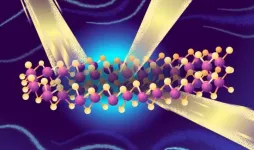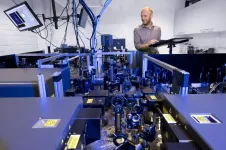Molybdenum disulfide ushers in era of post-silicon photonics
2021-03-03
(Press-News.org) Researchers of the Center for Photonics and Two-Dimensional Materials at MIPT, together with their colleagues from Spain, Great Britain, Sweden, and Singapore, including co-creator of the world's first 2D material and Nobel laureate Konstantin Novoselov, have measured giant optical anisotropy in layered molybdenum disulfide crystals for the first time. The scientists suggest that such transition metal dichalcogenide crystals will replace silicon in photonics. Birefringence with a giant difference in refractive indices, characteristic of these substances, will make it possible to develop faster yet tiny optical devices. The work is published in the journal Nature Communications.
The Scandinavian Vikings were the first, among others, to observe polarizing effects in optics. They discovered that objects appeared doubled when viewed through Iceland spar (clear calcite). That phenomenon was later called birefringence. The effect is due to the asymmetrical arrangement of atoms in some materials. As a result, a light beam refracts differently in the material,depending on the direction in which it propagates, splitting into two linearly polarized beams (the ordinary and extraordinary) and creating a doubled image.
It turns out that the phenomenon of birefringence is very practical. For example, the Vikings used double refraction of some crystals for navigation. Present-day liquid crystal monitors use the birefringence effect in liquid crystals to create images. The phenomenon is also used to build polarizers, wave plates, and other optical components. It is desirable that the refractive indices of ordinary and extraordinary beams differ as much as possible - then the desired effect can be achieved when light passes through a thinner plate, thus helping reduce the size of the device, and in some applications, increase its speed. Researchers have recently demonstrated the possibility of building ultra-compact waveguides with anisotropic materials to reach and even overcome the diffraction limit. The effect requires materials with a birefringence value greater than 1. So far, the BaTiS3 perovskite layered crystals and the hexagonal boron nitride h-BN have held the record for birefringence (0.8). The desire to make modern optics more and more compact has stimulated the search for natural materials with huge optical anisotropy greater than 1. Transition metal dichalcogenides are extremely promising in this respect. These compounds based on sulfur, selenium, tellurium, and 3d-elements of the Mendeleev's Periodic Table have a layered structure. For example, molybdenum disulfide (MoS2) consists of alternating layers rotated with respect to each other by 1800 and held together by weak van der Waals forces (Figure 1).
"From the task of measuring the optical properties of molybdenum disulfide, we have arrived at a completely different problem - namely, to study anisotropy and find promising applications of the anisotropy of such crystals in photonics," Georgy Ermolaev, Ph.D. student at MIPT and first author of the study, explains the authors' motivation. This anisotropic structure could not but affect the material's optical properties. This fact was known already in the second half of the twentieth century. However, quantitative measurements of the anisotropy were non-existent. That was due, among other things, to considerable experimental difficulties. To overcome them, the researchers combined methods of near and far electric fields. In other words, in addition to irradiating the material at different angles and detecting the signal, the authors studied the propagation of waveguide modes in the material. This approach enabled them to unambiguously determine the birefringence of the material, which is 1.5 in the near-infrared and up to 3 times in the visible range. These values are several times greater than those of previous record-breakers.
"We used a combination of techniques - spectral ellipsometry and near-field optical microscopy and verified our data with numerical calculations. The work required the efforts of a large number of scientists from different scientific teams in different countries and with different competencies. For all of us, this work was the beginning of large-scale research on anisotropic transition metal dichalcogenides nanophotonics," commented Aleksey Arsenin, a leading researcher at MIPT.
The data obtained were compared with quantum calculations, which, to the researchers' surprise, produced exactly the same result, thus confirming the correctness of the constructed quantum mechanical model of layered materials and suggesting that the theory and conclusions published in the article are applicable to the entire class of transition metal dichalcogenides.
The researchers have completely rediscovered for the world a class of materials with enormous optical anisotropy. The discovery offers an additional degree of freedom in the development of compact photonic devices and. For example, it makes it possible to reach the diffraction limit in optics for wave-guiding systems with characteristic dimensions of about 100 nanometers.
The work was led by Professor Valentyn Volkov. He moved from the University of Southern Denmark to MIPT in September 2019 to head the Center for Photonics and Two-Dimensional Materials. "Whereas previously we were limited to changes in geometry and effective refractive index to create new optical circuits and devices, giant anisotropy provides an additional degree of freedom to manipulate light," says Volkov. - Unexpectedly, we found out that naturally anisotropic materials enable us to build compact waveguides literally on the edge of the diffraction limit. It gives us an opportunity to compete with silicon photonics. Now we can safely not only talk about post-silicon photonics but also implement it.
INFORMATION:
[Attachments] See images for this press release:

ELSE PRESS RELEASES FROM THIS DATE:
2021-03-03
In a potential boost for quantum computing and communication, a European research collaboration reported a new method of controlling and manipulating single photons without generating heat. The solution makes it possible to integrate optical switches and single-photon detectors in a single chip.
Publishing in Nature Communications, the team reported to have developed an optical switch that is reconfigured with microscopic mechanical movement rather than heat, making the switch compatible with heat-sensitive single-photon detectors.
Optical switches in use today work by locally heating light guides inside a semiconductor chip. "This approach does not work for quantum optics," says co-author Samuel Gyger, a PhD student at KTH Royal Institute of Technology ...
2021-03-03
Just as James Cameron's Terminator-800 was able to discriminate between "clothes, boots, and a motorcycle", machine-learning could identify different areas of interest on 2D materials.
The simple, automated optical identification of fundamentally different physical areas on these materials (eg, areas displaying doping, strain, and electronic disorder) could significantly accelerate the science of atomically-thin materials.
Atomically-thin (or 2D) layers of matter are a new, emerging class of materials that will serve as the basis for next-generation energy-efficient computing, optoelectronics and future smart-phones.
"Without any supervision, machine-learning algorithms ...
2021-03-03
While consumers look out for the Dolphin Safe mark on seafood purchases, a major research stocktake of Australian-New Zealand waters gives new guidelines to managers of dolphin fisheries.
The extensive new genomic study of almost 500 common dolphins (Delphinus delphis), spanning multiple spatial areas of more than 1500 sq km from the southern and east coast of Australia to Tasmania and New Zealand, calls for greater collaboration between the two countries' conservation and fisheries plans.
Just published in Frontiers in Marine Science, the study of DNA diversity of several dolphin populations in Australia and NZ suggests connectivity between ...
2021-03-03
Care homes are at high risk of experiencing outbreaks of COVID-19, the disease caused by SARS-CoV-2. Older people and those affected by heart disease, respiratory disease and type 2 diabetes - all of which increase with age - are at greatest risk of severe disease and even death, making the care home population especially vulnerable.
Care homes are known to be high-risk settings for infectious diseases, owing to a combination of the underlying vulnerability of residents who are often frail and elderly, the shared living environment with multiple ...
2021-03-03
As odd as it sounds, many scientists have attempted to place extremely small diamonds inside living cells. Why? Because nanodiamonds are consistently bright and can give us unique knowledge about the inner life of cells over a long time. Now physics researchers at Lund University in Sweden have succeeded in injecting a large number of nanodiamonds directly to the cell interior.
Diamonds are not only sought after for their beauty, but also for their uniquely luminescent properties, at least among scientists. Unlike other fluorescent materials, they do not bleach.
"We actually think of them as a dye. In addition, they are biocompatible", says Elke Hebisch, researcher at solid state physics at Lund University.
Together ...
2021-03-03
European Union law rules that Member States must provide fair and appropriate compensation for victims of sexual offences. In some countries, few victims receive any financial compensation, or often the amount received is very low. According to figures from the Spanish Government's Ministry of Finance, obtained by professor of Criminal Law at the UOC, Josep M. Tamarit, between 1998 and 2018 in Spain some 1,356 applications for public compensation were made, of which 272 were favourably settled. "During these two decades, only 20% of the compensation ...
2021-03-03
A team of scientists has, for the first time, identified landfalls of tropical cyclones (TCs) in Japan for the period from 1877 to 2019; this knowledge will help prepare for future TC disasters.
In recent years strong TCs have been making landfalls in Japan, such as Typhoon Jebi in 2018, which severely hit the Kinki region, and Typhoon Hagibis in 2019, which severely hit eastern Japan. While Japan has suffered from a number of TC impacts throughout its history, meteorological data for these events has been sparse.
The team, including Specially Appointed Associate Professor Hisayuki Kubota of the Faculty of ...
2021-03-03
While the digitization process offers an extensive list of opportunities, it also presents a number of challenges for higher education institutions, a primary one of which is learner authentication in online education. More and more higher education establishments are making use of digital learning environments (DLE), and electronic assessment systems are now an increasingly important element in the digital age, both for academic institutions and for students, including those with special educational needs and disabilities (SEND).
David Bañeres is a researcher with the IN3 SOM Research Lab group and professor at the Faculty ...
2021-03-03
Climate experts have revealed that rising temperatures will intensify future rainfall extremes at a much greater rate than average rainfall, with largest increases to short thunderstorms.
New research by Newcastle University has shown that warming temperatures in some regions of the UK are the main drivers of increases in extreme short-duration rainfall intensities, which tend to occur in summer and cause dangerous flash flooding.
These intensities are increasing at significantly higher rates than for winter storms. A study, led by Professor Hayley Fowler, of Newcastle University's School of Engineering, highlights the urgent need for climate change adaptation measures as heavier short-term rainfall increases ...
2021-03-03
As is sensed in our daily life, jiaozi frozen in domestic refrigerator tastes less delicious than an instant frozen one sold in the supermarket. The formation of the ice crystal is to blame. In scientific researches ranging from aerospace to biology and medicine, the formation, growth and elimination of the ice crystal are of significant importance.
By far, slow freezing and vitrification are generally adopted for cryopreservation. The former method, assembling freezing jiaozi with domestic refrigerator, is accompanied by mass formation of ice crystal which inevitably does irreversible damage to the cell. Vitrification effectively avoids former problems but requires either extremely rapid freezing rate which is too hard to achieve or high ...
LAST 30 PRESS RELEASES:
[Press-News.org] Molybdenum disulfide ushers in era of post-silicon photonics




